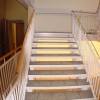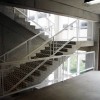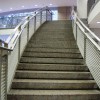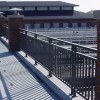Metal Railings
Video
alt="" Custom metal railing designs Fusion TVMetal railing systems are a typical solution for applications that include stairs, ramps, drop offs and uneven walkways. Metal railings utilize the same basic structural components as wood railings; a top handrail, a bottom rail or track, balusters or newel posts for main load transfer to the walking surface, and infill panels, pickets or spindles.
While the design of railing systems must meet stringent code requirements for safety and structural support, metal railing systems offer a broad range of design options from a basic picket rail to an industrial wire mesh panel to custom artistic designs. The structural capacity, durability and ease of fabrication of metal railing systems provide some advantage over wood railings, but are generally more expensive.
Metal railing systems can be field fabricated or built at a metal shop using job specific shop drawings and delivered to the site in segments for installation. Metal railing systems are available in a several materials, such as steel, stainless steel, aluminum, etc. Common steel railing systems are fabricated from standard steel pipe or tube shapes. Stainless steel railings often integrate glass panels with custom newel post and handrails. Attachment methods can include both welding and mechanical fastening. Aluminum railings can be more cost effective with several standard systems that utilize easy to assemble components and attachment brackets. A variety of coatings and finishes are available depending on material and the final intended use. These factory finishes can add beauty as well as increase the lifespan of a metal railing.
The primary concerns in the design and construction of a metal railing system are structural loads and safety barrier requirements. Building codes and accessibility codes such as ADA and OSHA set the standards for railings and handrails. Structurally, a railing must be design to withstand a load of 200-300lbs exerting a force against it, though local codes must be consulted for specific load requirements. Safety standards require that railings and handrails are at least 34” to 36” above the finish surface in height, though some applications require 42” railing height. Handrails need to be between 1-1/4" - 2" in diameter with a minimum of 1-1/2' clearance between the adjacent wall of rail surface. Codes also require that a 4" diameter ball not be allowed to pass thru the railing, which typically allows for a maximum distance of 4” between vertical pickets.
Related Topics
Pipe and Tube Railings ( 05 52 13 )
Metal Stairs ( 05 51 00 )
Decorative Metal Railings ( 05 73 00 )
Glazed Decorative Metal Railing Assemblies ( 05 73 13 )
Wire Rope Decorative Metal Railings ( 05 73 16 )

Buildipedia Staff
The Buildipedia research and writing staff consists of dozens of experienced professionals from many sectors of the industry, including architects, designers, contractors, and engineers.
Website: buildipedia.com/






